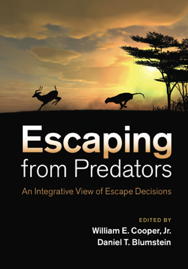 The 15 species of marmots make an ideal experimental system to ask questions about the evolution of social behavior and communication because they live in a variety of habitats, exhibit a range of social systems, and all species emit between one and five types of alarm calls. Past studies have focused on the meaning of these calls. Current work focuses on yellow-bellied marmots at the Rocky Mountain Biological Laboratory in Colorado to better understand the evolution of alarm calling and social variation, antipredator behavior, as well as how alpine animals respond to climate change. The behavior and population biology of the marmots of RMBL have been continuously studied since 1962. Exciting new research directions focus on understanding reproductive suppression in females, coalitionary alliances in males, the consequences of social relationships, and the importance of ‘stress’ in reproduction and health. Visit the RMBL Marmot Project website for more information and a comprehensive list of publications. The 15 species of marmots make an ideal experimental system to ask questions about the evolution of social behavior and communication because they live in a variety of habitats, exhibit a range of social systems, and all species emit between one and five types of alarm calls. Past studies have focused on the meaning of these calls. Current work focuses on yellow-bellied marmots at the Rocky Mountain Biological Laboratory in Colorado to better understand the evolution of alarm calling and social variation, antipredator behavior, as well as how alpine animals respond to climate change. The behavior and population biology of the marmots of RMBL have been continuously studied since 1962. Exciting new research directions focus on understanding reproductive suppression in females, coalitionary alliances in males, the consequences of social relationships, and the importance of ‘stress’ in reproduction and health. Visit the RMBL Marmot Project website for more information and a comprehensive list of publications.
Links:
Popular Press:
Popular press for the PNAS heritable victimization article:
Popular press about the marmot masculinization work: Celebrate groundhog day long enough and the press comes! A fun article from the LA Times. Our PRSB paper about heritable alarm calls was a hit in German speaking parts of the world as was our PRSB paper about the delayed beneifts of play: Marmots and marmot research featured in a long article in Men’s Journal about climate change and the end of skiing in Aspen, Colorado. A fun interview about marmots and climate change on WBEZ-Chicago’s EcoMyths radio show. Our Behavioral Ecology paper about how less popular marmots emit more alarm calls got some press in ScienceShots, and the Times Live. A fun newspaper article about a couple who has created an amazing video archive of woodchuck behavior. Dan and Tina’s social network work featured in a long feature in BioScience. A wonderful video from 9NEWS (NBC Denver) about the soap opera (The book of marmot?!) that is our RMBL study. Dan’s 2024 Groundhog Day essay in MSNBC. The marmots are featured in an UnDark piece about social behavior. The Scientist article about the link between sociality and the marmot gut microbiome. Two great Rocky Mountain PBS pieces about the marmot project and the RMBL from 2024: Facing climate change in one of Colorado’s most remote wintertime laboratories; Gothic’s Outdoor Science Lab Xochitl and Dan’s Conversation piece about marmot cumulative adversity. |
 Popular press for the 22 July 2010 Nature cover story about how shorter winters have led to fatter marmots and a population explosion over the past decade includes: Popular press for the 22 July 2010 Nature cover story about how shorter winters have led to fatter marmots and a population explosion over the past decade includes:
Talks:
|
 Virtually all animals are vulnerable to predation at some point in their lives and a key response to predators is flight. Colleagues and I have generated large data sets in birds, mammals, and lizards to understand the evolution of escape behavior. Through many empirical studies and large-scale comparative studies and meta-analyses, we have identified key factors that explain variation in escape behavior. By identifying mechanisms that influence flight initiation distance, we are able to apply this knowledge to understanding human tolerance of wildlife. Virtually all animals are vulnerable to predation at some point in their lives and a key response to predators is flight. Colleagues and I have generated large data sets in birds, mammals, and lizards to understand the evolution of escape behavior. Through many empirical studies and large-scale comparative studies and meta-analyses, we have identified key factors that explain variation in escape behavior. By identifying mechanisms that influence flight initiation distance, we are able to apply this knowledge to understanding human tolerance of wildlife.
Popular Press: |
